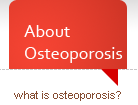
Treatment
As an osteoporotic fracture is painful, patients should receive adequate pain relief. All patients should also receive adequate calcium and vitamin D, and this should be continued throughout the course of treatment. All the treatments for osteoporosis can slow down the rate of bone loss and/or reduce the risk of future fractures.
| 1. | Pain Relief | Following a fracture, you may be in considerable pain. This may be relieved by pain killers, physiotherapy or hydrotherapy in the short term. At home, local heat or ice packs may be helpful. | ||||||
| 2. | Calcium and vitamin D | As part of the treatment for osteoporosis, you should get adequate calcium and vitamin D. It is recommended to take 1000 mg of calcium daily (the total from both food and supplements) and 800 IU of vitamin D daily. | ||||||
| 3. | Raloxifene | Is a selective estrogen receptor modulator, or SERM, used to treat breast cancer. It is also approved by the FDA to prevent and treat osteoporosis. | ||||||
| 4. | Bisphosphonates | Are a class of drugs for osteoporosis which inhibit bone resorption. They all slow down bone loss and prevent fractures. There are many ways to take bisphosphonates:
|
||||||
| 5. | Denosumab | Inhibits bone resorption to increase bone density and reduce osteoporotic fractures. It is given by a subcutaneous injection once every 6 months. | ||||||
| 6. | Strontium | Strontium works by stimulating bone formation and reducing bone resorption. It improves bone density and reduces fractures. It is taken daily. | ||||||
| 7. | Parathyroid hormone (PTH) | Is a hormone naturally produced by our bodies. Given daily by subcutaneous injection, it stimulates bone formation leading to increased bone density and reduction in fractures. | ||||||
| 8. | Hormone therapy | Can be used for the prevention of bone loss in postmenopausal women who have menopausal symptoms. |
Copyright 2010 Persatuan Osteoporosis All Rights Reserved




